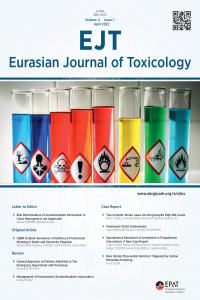Orhan DELİCE, Murat DAŞ, Gülhan KURTOĞLU ÇELİK, Havva ŞAHİN KAVAKLI, Salim NEŞELİOĞLU, Semra IŞIKOĞLU HATIL
Acil Serviste Karbonmonoksit Zehirlenmesi Tanısı Alan Hastalarda Plazma Total Tiyol Seviyelerinin Değerlendirilmesi
Anahtar Kelimeler:
karbon monoksit zehirlenmesi, , oksidatif stres, total tiyol seviyeleri
Evaluation of Plasma Total Thiol Levels in Patients with Carbon Monoxide Poisoning in the Emergency Department
Objective: The study aimed to measure the levels of total thiol, an antioxidant parameter, in patients who presented to the emergency department (ED) with carbon monoxide (CO) poisoning under normobaric oxygen therapy (NBOT), evaluate the time-dependent changes in total thiol levels within the first 6 hours, and examine the course of antioxidants in CO poisoning.
Materials and Method: The study population consisted of 85 patients diagnosed with CO poisoning in the ED and 50 volunteers. Total thiol level was measured in the study group at the admission (T0), first (T1) and sixth hour (T6). Carboxyhemoglobin levels, cardiac markers, electrocardiography, and routinely requested tests were investigated in patients with poisoning. The total thiol level was measured in the volunteer group.
Results: There was a significant decrease in total thiol mean levels between T0 and T1 (p <0.01), a significant increase between T1 and T6 (p <0.01), and a significant increase between T0 and T6 (p <0.01). No significant difference was found for T6 total thiol mean level between the patient and the control group (p >0.05).
Conclusion: The significant decrease in the total thiol mean value from T0 to T1 may suggest that the oxidative stress continues within the first hour, and the initiation of the significant increase in the total thiol level within T1 may indicate that the oxidative stress decreased with treatment. Six hours of NBOT protocol is sufficient for acute CO poisoning in patients not requiring HBOT.
Keywords:
carbon monoxide poisoning, oxidative stress, total thiol level,
___
- Maloney G. Carbon Monoxide Poisoning. In: Tintinalli JE. Stapczynski JS. Ma OJ,Cline DM, Cydulka RK, Meckler GD; Emergency Medicine. Mc Graw-Hill New York 2011; p.1410- 1413.
- Aslan S, Erol MK, Karcioglu O, Meral M, Cakir Z, Katirci Y. The investigation of ischemic myocardial damage in patients with carbon monoxide poisoning. Anadolu Kardiyol Derg. 2005; 5: 189-93
- Raub JA. Health effects of exposure to ambient carbon monoxide. Global Change Science. 1999;1:331–351.
- Satran D, Henry CR, Adkinson C, Nıcholson CI, Bracha Y, Henry TD. Cardiovascular Menifestations of moderate to severe carbon monoxide poisoning. J Am Coll Cardiol. 2005;45(9):1513-16.
- Kao LW, Nanagas KA. Carbon monoxide poisoning. Emerg Med Clin North Am. 2004; 22: 985-1018.
- Brent J.A., Rumack H.H, Role of free radicals in toxic hepatic Injury 1.free radical biochemistry, Clinical Toxicolory,1991 ;31:139-171.
- Chung, K. et al. Generation of free radical by interaction of iron with thiols in human plasma and its possible significance. Thromb Res, v. 2005;116: 157-164. Pogockı D., Schöneıch C. Thiyl radicals abstract hydrogen atoms from carbohydrates: reactivity and selectivity. Free Radic Biol Med, 2001;.31: 98-107.
- Hu ML. Measurement of protein thiol groups and glutathione in plasma. Methods Enzymol 1994; 233: 380-385.
- Smith C, Marks Allan D, Lieberman M. Basic Medical Biochemistry. Second Edition. Philadelphia: Lippincott Williams & Wilkins; 2005;441-442.
- Yardim-Akaydin S, Ozkan Y, Ozkan E, Torun M, Simsek B. The role of plasma thiol compounds and antioxidant vitamins in patients with cardiovascular diseases. Clin Chim Acta. 2003; 338(1-2):99-105.
- Cao, G.; Alessıo, H. M.; Cutler, R. G. Oxygen-radicalabsorbance capacity assay for antioxidants. Free Rad BiolMed, v. 1993; 9(14): 303-311.
- Zhang J, Piantadosi CA. Mitochondrial oxidative stress after carbon monoxide hypoxia in the rat brain. J Clin Invest. 1992 ;90(4):1193-1199.
- Garrabou G. et al. Mitochondrial injury in human acute carbon monoxide poisoning: the effect of oxygen treatment. J Environ Sci Health C Environ Carcinog Ecotoxicol Rev. 2011;29(1):32-51.
- Taskiran D, Nesil T, Alkan K. Mitochondrial oxidative stress in female and male rat brain after ex vivo carbon monoxide treatment. Hum Exp Toxicol. 2007 ;26(8):645-651.
- Kavakli HS, Erel O, Delice O, Gormez G, Isikoglu S, Tanriverdi F. Oxidative stress increases in carbon monoxide poisoning patients. Hum Exp Toxicol. 2011; 30(2):160-164
- Yayın Aralığı: Yılda 3 Sayı
- Başlangıç: 2019
- Yayıncı: Acil Tıp Uzmanları Derneği
Sayıdaki Diğer Makaleler
Orhan DELİCE, Murat DAŞ, Gülhan KURTOĞLU ÇELİK, Havva ŞAHİN KAVAKLI, Salim NEŞELİOĞLU, Semra IŞIKOĞLU HATIL
Kalsiyum Asetat Alımı Sonrası Dilde Olağandışı Aşırı Şişlik: Olgu Sunumu
Reversible Splenial Corpus Callosum Lesion and Carbamazepine
Datura Zehirlenmesi ile Acile Başvuran 7 Kardeş: Kuzey Suriye’den Olgular
Bahadır KARACA, Burak ÇELİK, Murat TEPE, Buğra YILDIRIM
